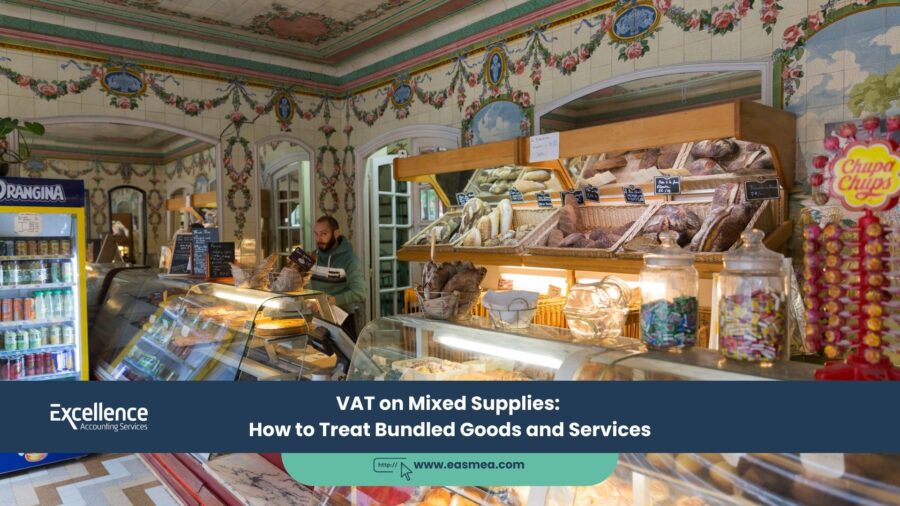VAT on Mixed and Composite Supplies: A Guide to Bundled Goods and Services in the UAE
In the competitive UAE market, businesses are constantly creating attractive offers to entice customers. A common strategy is to “bundle” multiple goods or services together for a single price. Think of a hotel’s “dinner, bed, and breakfast” package, a luxury gift basket containing various items, or a service contract for a machine that includes spare parts. While great for marketing, these bundled supplies create a significant challenge for VAT accounting: **How do you apply the correct VAT rate when the bundle contains items that are taxed differently?**
This is not a simple question. The UAE VAT Law makes a crucial distinction between a **”Composite Supply”** and a **”Mixed Supply.”** Applying the wrong treatment can lead to under- or over-charging VAT, resulting in incorrect tax filings, dissatisfied customers, and potential penalties from the Federal Tax Authority (FTA). Understanding this distinction is essential for any business that sells products or services in a package.
This guide will provide a clear explanation of the difference between mixed and composite supplies. We will break down the FTA’s rules, provide practical examples, and outline the correct VAT treatment for each, ensuring your business remains compliant.
Key Takeaways
- Not All Bundles are Equal: The VAT treatment of a bundled sale depends on whether it is a “Composite Supply” or a “Mixed Supply.”
- Composite Supply = One Main Item: This is a bundle where there is one principal or main component, and the other items are ancillary. The entire bundle takes the VAT rate of the **principal component**.
- Mixed Supply = Multiple Independent Items: This is a bundle of two or more distinct items sold for a single price that are not naturally bundled. The price must be **apportioned**, and the correct VAT rate applied to each individual item.
- The “Naturally Bundled” Test: A key question to ask is whether the items are naturally supplied together in the ordinary course of business. If so, it’s likely a composite supply.
- Getting it Wrong is Risky: Incorrectly treating a mixed supply as a composite supply (or vice-versa) can lead to significant VAT errors and compliance issues. Professional VAT consultancy is key.
Defining the Terms: Composite vs. Mixed Supply
The entire issue hinges on understanding the legal definitions of these two types of supplies.
1. Composite Supply: One Dominant Element
A composite supply is a bundle where there is one clear **principal supply** and one or more other supplies that are **ancillary** to it. Ancillary means they are not the main aim for the customer but are necessary for the better enjoyment of the main supply.
The Rule: The entire transaction is treated as a single supply of the principal component. The VAT rate applicable to the principal supply is applied to the full price of the bundle.
Example: A Laptop with a Pre-installed Operating System
When you buy a new laptop, it comes with an operating system (e.g., Windows) already installed. The laptop is the principal supply (standard-rated at 5%), and the software is ancillary. The customer’s aim is to buy a functioning laptop, not the individual components. Therefore, the entire price is subject to 5% VAT.
2. Mixed Supply: A Collection of Independent Items
A mixed supply is a bundle of two or more individual items that are sold together for a single price, but which are not naturally bundled. Each item could be sold separately and is not dependent on the others.
The Rule: The transaction is treated as if each item were sold separately. You must **apportion** the single price among the individual items (based on their standalone selling prices) and apply the correct VAT rate to each portion.
Example: A Gift Basket
A gift basket sold for AED 300 contains standard-rated items (chocolates, biscuits) and zero-rated items (raw nuts, coffee beans). These items are not naturally bundled and could be sold separately. This is a mixed supply. The seller must apportion the AED 300 price based on the individual market values of the items and apply 5% VAT to the value of the standard-rated goods and 0% to the value of the zero-rated goods.
Key Differences at a Glance
| Aspect | Composite Supply | Mixed Supply |
|---|---|---|
| Nature of Items | One principal item with ancillary/dependent items. | Two or more independent items. |
| “Naturally Bundled”? | Yes, typically supplied together. | No, artificially bundled for a single price. |
| VAT Treatment | Single VAT rate applied to the whole bundle (rate of the principal item). | Price is apportioned, and VAT is applied to each item individually. |
| Classic Example | Hotel stay with breakfast included. | Gift basket with various unrelated items. |
Clarity on Complex Transactions with Excellence Accounting Services (EAS)
Correctly classifying bundled supplies is a common challenge that requires a clear understanding of the VAT law. The expert team at EAS provides the guidance you need to ensure compliance and avoid costly errors.
- Specialized VAT Consultancy: We analyze your product and service bundles and provide clear, defensible advice on whether they should be treated as composite or mixed supplies.
- VAT Return Filing and Review: We manage your VAT return filing, ensuring that complex transactions like these are reported correctly. We can also review past returns to identify and rectify any potential errors.
- Process and Policy Advisory: We help you set up your invoicing and accounting and bookkeeping systems to correctly handle the apportionment and reporting of mixed supplies.
- FTA Audit Support: In the event of an audit, we can provide the documentation and legal reasoning to support your VAT treatment of bundled supplies.
Frequently Asked Questions (FAQs)
In this case, the distinction is less critical from a calculation perspective, as the entire bundle will be subject to 5% VAT regardless. However, for accurate internal reporting and analysis, it is still good practice to understand the nature of your supply.
You must apportion the single price based on the standalone selling price of each individual item in the bundle. For example, if a bundle costs AED 100 and contains Item A (standalone price AED 80) and Item B (standalone price AED 40), you would allocate two-thirds of the price (AED 66.67) to Item A and one-third (AED 33.33) to Item B.
No. This is generally treated as a discount on the first item. The “free” item has no value for VAT purposes. You would charge VAT on the price the customer actually pays for the first item.
This is most likely a composite supply. The principal supply is the machine. The maintenance contract, especially if it’s a standard inclusion, is ancillary to ensure the machine functions correctly. The entire price would typically be subject to 5% VAT.
Delivery is almost always considered an ancillary part of the supply of the goods. Therefore, it forms part of a composite supply. The delivery charge takes the same VAT rate as the goods being delivered. If the goods are standard-rated, the delivery charge is also standard-rated.
The most common error is to default to treating everything as a composite supply and applying a single VAT rate without proper analysis. This is especially risky if the bundle contains zero-rated or exempt items, as it can lead to overcharging VAT and compliance issues.
For a composite supply, you can list the single bundle for a single price. For a mixed supply, your invoice must show a breakdown of the different components and the different VAT rates and amounts applied to each, even if the customer pays one total price.
This is a classic mixed supply scenario. If you sell a package that includes a standard-rated hotel stay and an exempt metro pass for a single price, you must apportion the price. The portion related to the hotel stay is subject to 5% VAT, and the portion related to the metro pass is exempt.
You should maintain records of the standalone selling prices of all items included in a mixed supply to support your apportionment calculation. For composite supplies, you should have a clear commercial justification for why one item is considered principal and the others are ancillary.
If you are in doubt, you should seek professional advice from a qualified tax advisor or submit a request for a “VAT Clarification” to the FTA. It is always better to get clarity upfront than to risk penalties later.
Conclusion: Clarity is Key to Compliance
In a drive to create value for customers, businesses will continue to innovate with bundled offers. For financial managers, the key is to ensure that this marketing creativity is matched with VAT compliance discipline. By carefully analyzing each bundle to determine whether it is a composite or mixed supply, and by applying the correct VAT treatment accordingly, you can protect your business from risk, ensure fair pricing for your customers, and maintain a healthy relationship with the tax authorities.
Confused by Bundled Sales? Get VAT Clarity.
Contact Excellence Accounting Services for an expert review of your product and service bundles to ensure you are applying VAT correctly.




